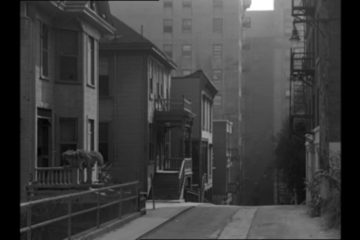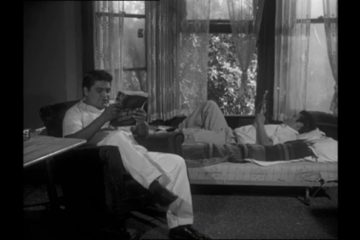The Exiles (1961) is a documentary-style film which uses real life stories to explore themes of race, gender, and isolation in a group of young Native Americans living in San Francisco. We follow three characters: Yvonne, her husband Homer, and his friend Tommy. Through these characters we glimpse the complex struggles facing Native Americans as ‘exiles’ in the city. In this sequence, mise-en-scene functions literally and symbolically to explore gender roles in a discriminatory society.

The sequence begins with Yvonne climbing a hill with a bag of shopping (fig.1). This can be read as a metaphorical depiction of her up-hill struggle. The hill functions as an obstacle, as do the gate and doors later on. At no point is she offered any help, or even acknowledged, despite being pregnant. This is an example of the film’s use of mise-en-scene to examine the struggles of women. She is alone and isolated in the street, as in her home life. Sherman Alexie describes the film as being haunted, noting that “The people are ghosts, the buildings are ghosts. It’s a haunting and haunted film” (qtd. in Campbell, 176). The shot of the deserted street and gaping windows is a particularly effective illustration of this.

Yvonne is depicted as isolated and distanced from the group of men in her home throughout the sequence. We see her cooking for them and she does not eat the food herself; only the men eat the food, signifying gender inequality. Similarly, Yvonne is on the outside looking in: she is framed as isolated, in separate rooms to the men, usually in a separate shot. When she is shown in shots with the men, it is to further emphasise her detachment (fig.2). The shallow depth of field, her lowered head, and her positioning below her husband are used to draw attention to her subordinate position. Homer appears much larger in comparison: his body dominates the frame. Their positioning in separate rooms reinforces her sense of loneliness, and lack of control over her own life. The door frame emphasises this and foreshadows the ending of the film, when she is seen watching Homer and his friends through a window as they return home from a night out. This is a demonstration of the contrasts between masculinity and femininity constructed by a patriarchal society (Benshoff and Griffin, 214-5). Yvonne functions in this clip as an example of the ideological and cultural expectation of women’s to adopt roles as wives and mothers and be subservient to men.

The men in the sequence are presented as an extreme contrast to the hard-working soon-to-be mother. They are depicted as lazy, misogynistic, and superficial. They are introduced lying around reading comics and sleeping: a representation perhaps of conforming to an American lifestyle (fig.3). This is later reinforced through their ‘masculine’ actions of playing poker, fighting, and picking up women. In the sequence they are again shown conforming to American values: superficiality as we see them showing off a shirt and shaving in preparation to go out; and consumerism through images of eating, and an attempt to steal from the sleeping man. They are depicted as removed from their cultural background physically, which symbolises the men as also ‘removed’ emotionally (Campbell, 177). Perhaps the insecurity felt by the men, as a result of their displacement from society due to racial marginalisation, is in turn a cause of their misogynistic and derogatory attitudes towards women. This is demonstrated through their treatment of women as either maternal (as in this sequence) or through sexual objectification (later in the film).
The film shows Native Americans living in a state of exile within the city, and this sequence uses mise-en-scene to portray Yvonne as an example of female oppression in a male-dominated society, depicting her as displaced even from the exiles themselves. The men conform to American values of consumerism and superficiality, and patriarchal societal roles, yet they remain detached and unhappy. As men they are allowed more freedom, as represented through their positioning next to a window (fig.3), in comparison to Yvonne’s entrapment and isolation (fig.2). The characters in the film, based on real people, claim to enjoy living in the city yet are unhappy (perhaps the pregnancy could be viewed as a qualified optimism and hope for the future). The film therefore deals with the very real, complex, and paradoxical struggles facing Native American women and men.
References
Benshoff, H. and Griffin, S. (2009). America on Film: Representing Race, Class, Gender, and Sexuality at the Movies. Malden: Wiley-Blackwell, 2009. Print.
Campbell, Neil. Post-Westerns: Cinema, Region, West. Nebraska: University of Nebraska Press, 2013. Print.
Fugikawa, Laura Sachiko. ‘Shifting the Gaze: Gender and Resilience in The Exiles‘. American Quarterly. 67.1 (2015): 1-14. Print.
Schweninger, Lee. Imagic Moments: Indigenous North American Film. Georgia: University of Georgia Press, 2013. Print.

Elinor Jenkins is BA Hons Film Studies student at QMUL. She is from Pembrokeshire in Wales and aspires to work in film/television research. She volunteers at the Welsh National Archives and enjoys traveling and exploring new places.
Please obtain permission before redistributing. Copyright © 2018 Elinor Jenkins